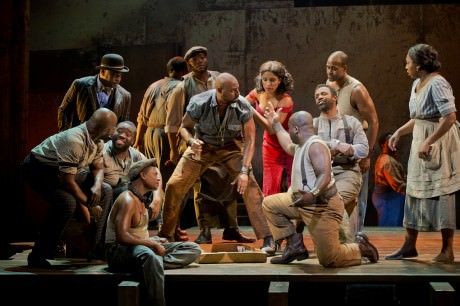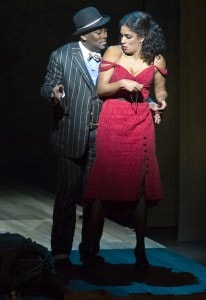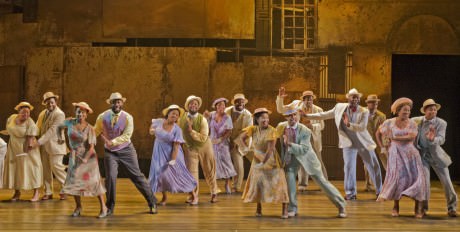History hit an astounding “rewind” and “refresh” button last night at The National Theatre. An abundantly assorted audience of Washingtonians rose as one to applaud an iconic work of musical theater with a past so complicated and conflicted that such heartfelt unanimity would have been unthinkable back in 1936 when the show first came to town. So rich in passion and talent is this revisioned version of Porgy and Bess that though billed as The Gershwins’, it ought rightly be acclaimed as the twenty-first century’s.

An awesomely insightful creative team led by Tony Award-winning Director Diane Paulus, book adapter Suzan-Lori Parks, and musical score adapter Diedre L. Murray has done a number on Porgy and Bess that’s a winner. And just in time. The original—with music by George Gershwin and book and lyrics by DuBose & Dorothy Heyward and Ira Gershwin—has been rethunk and revamped for decades, but it had settled into its long lifespan like a somewhat awkward artifact.
I’ve been perusing Ellen Noonan’s The Strange Career of Porgy & Bess: Race, Culture, and America’s Most Famous Opera, which relates this sometimes shocking and unsettling history up to 2012 when the production now on national tour first opened on Broadway. What stands out for me is how this classic American folk opera has come to represent the aspirations of extraordinary actors, singers, and other theater craftspeople to make art that does not so much imitate life as triumph over it. Take, for instance, the show’s first run in DC, when Anne Brown, the original Bess (and a Baltimore native), and Todd Duncan, the original Porgy (a Howard University music professor), inspired the cast to strike in order to force the National Theatre’s management to suspend its segregation policy.
Over the years Porgy and Bess has been deplored for its depiction of black Americans, and with good reason: The show’s dispiriting parade of poverty, violence, and drug dealing through a neighborhood that would today be dubbed urban blight is problematic, to say the least. As Noonan reports, when Harry Belafonte famously turned down the role of Porgy in the 1950s film version, he said of the Dubose Heyward script, “All that crap shooting and razors and lusts and cocaine is the old conception of the Negro.” Sidney Poitier went on to play the role (when he realized that producer Samuel Goldwyn would put the kibosh on his career if he did not), but in his later memoir,
the actor recalled his feeling that Porgy and Bess was “an insult to black people,” and he characterized as “outrageous bullshit” Goldwyn’s belief that the opera was “one of the greatest things that has ever happened for the black race.”
Perhaps tellingly, when the current Porgy and Bess was announced, there was no equivalent chorus of critical barbs from black actor-singers (for whom the show has always offered plum roles). Instead it was a white guy, the estimable Stephen Sondheim, who laced into the production (before it opened) with a letter to the New York Times in which he called “dismaying” what he believed to be “the disdain that Diane Paulus…and Suzan-Lori Parks feel toward the opera itself.”

I cite these details from the show’s fascinating back story not to inflame but to underscore just how phenomenal is the performance now on stage at the revived and revitalized National.
Right from the opening strains of the Overture, the score as adapted by two-time Obie Award winner Diedre L. Murray (with marvelous orchestrations by William David Brohn and Christopher Jahnke) rings brightly with a liveliness and life force that feels completely contemporary.
And the cast, the cast! Glorious one and all. Each in their own way brings their classic character to life in a way that is completely credible and approachable right now—Alicia Hall Moran (Bess), Nathaniel Stampley (Porgy), Alvin Crawford (Crown), Kingsley Leggs (Sporting Life), Sumayya Ali (an alum of the Duke Ellington School of the Arts!) as Clara, Denisha Ballew (Serena), Danielle Lee Greaves (Mariah), and David Hughey as Jake—all around whom the members of the chorus sing with such resounding brilliance as to prompt one’s soul to stir.

Ronald K. Brown has graced the show with choreography that captures and celebrates the company’s verve with no stereotypical shuffle and jive. Riccardo Hernandez has designed a beautiful minimalist set that evokes a sense of place with no classist presumption. Esosa’s costumes are character-specific without condescension and at times display real loveliness (as during the picnic scene). And Christopher Akerlind’s lighting design, an ever-moving intangible presence, animates each stunning stage picture peopled by Paulus, one after another and another.
Pulitzer Prize winning playwright Suzan-Lori Parks has done many smart and astute things to the text of Porgy and Bess. One striking example: When Porgy sings “I Got Plenty of Nothing,” he does so with a big grin on his face, having just consummated offstage his crush on Bess. In Parks’ reworking, nothing now means something—and the audience shares instantly in his delight. Parks has abandoned the original’s phonetic spelling throughout so as to allow actors to discover their characters’ diction unconstrained by the creators’ superciliously broad notation of Gullah dialect. And in countless instances Parks has tweaked the script such that the effect is no longer a demeaning museum piece but an exuberantly embodied story of community and caring, misfortune and survival, loneliness and love.
This is no masterpiece dusted off simply to redeem its unsavory past. This is art keeping pace with life. And it succeeds magnificently.

The Gershwins’ Porgy and Bess plays through this Sunday, December 29, 2013 at The National Theatre – 1321 Pennsylvania Avenue, NW, in Washington, DC. For tickets, (800) 514-3849, or purchase them online.
LINK
Sydney-Chanele Dawkins’ review of The Gershwins’ Porgy and Bess on DCMetroTheaterArts.




